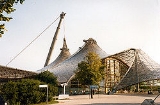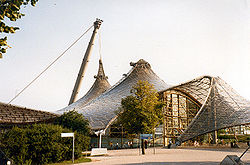
Günter Behnisch
Encyclopedia
Günter Behnisch was a German
architect
, born in Lockwitz, near Dresden
. He was one of the most prominent architects representing deconstructivism
.
Günter Behnisch studied architecture at the Technical University in Stuttgart
. One of his most notable buildings was the new parliament in the West German capital, Bonn
. Although he won the architectural design competition in 1973, the construction only began in 1987, and was completed in 1992.
He established his own architecture practice in Stuttgart
in 1952, which in 1966 became Behnisch & Partner.
His son Stefan Behnisch established a separate firm, Behnisch Architekten
in 1989.

Germany
Germany , officially the Federal Republic of Germany , is a federal parliamentary republic in Europe. The country consists of 16 states while the capital and largest city is Berlin. Germany covers an area of 357,021 km2 and has a largely temperate seasonal climate...
architect
Architect
An architect is a person trained in the planning, design and oversight of the construction of buildings. To practice architecture means to offer or render services in connection with the design and construction of a building, or group of buildings and the space within the site surrounding the...
, born in Lockwitz, near Dresden
Dresden
Dresden is the capital city of the Free State of Saxony in Germany. It is situated in a valley on the River Elbe, near the Czech border. The Dresden conurbation is part of the Saxon Triangle metropolitan area....
. He was one of the most prominent architects representing deconstructivism
Deconstructivism
Deconstructivism is a development of postmodern architecture that began in the late 1980s. It is characterized by ideas of fragmentation, an interest in manipulating ideas of a structure's surface or skin, non-rectilinear shapes which serve to distort and dislocate some of the elements of...
.
Günter Behnisch studied architecture at the Technical University in Stuttgart
University of Stuttgart
The University of Stuttgart is a university located in Stuttgart, Germany. It was founded in 1829 and is organized in 10 faculties....
. One of his most notable buildings was the new parliament in the West German capital, Bonn
Bonn
Bonn is the 19th largest city in Germany. Located in the Cologne/Bonn Region, about 25 kilometres south of Cologne on the river Rhine in the State of North Rhine-Westphalia, it was the capital of West Germany from 1949 to 1990 and the official seat of government of united Germany from 1990 to 1999....
. Although he won the architectural design competition in 1973, the construction only began in 1987, and was completed in 1992.
He established his own architecture practice in Stuttgart
Stuttgart
Stuttgart is the capital of the state of Baden-Württemberg in southern Germany. The sixth-largest city in Germany, Stuttgart has a population of 600,038 while the metropolitan area has a population of 5.3 million ....
in 1952, which in 1966 became Behnisch & Partner.
His son Stefan Behnisch established a separate firm, Behnisch Architekten
Behnisch Architekten
Behnisch Architekten is an architectural practice based in Stuttgart, Germany, with branches in Venice, California and Boston, Massachusetts.The office was founded in 1989 by Stefan Behnisch, son of the well-known German architect Günter Behnisch...
in 1989.
Completed projects

- 1972 Olympic ParkOlympiapark, MunichThe Olympiapark in Munich, Germany, is an Olympic Park which was constructed for the 1972 Summer Olympics. Found in the area of Munich known as the "Oberwiesenfeld" , the Park continues to serve as a venue for cultural, social, and religious events such as events of worship...
in MunichMunichMunich The city's motto is "" . Before 2006, it was "Weltstadt mit Herz" . Its native name, , is derived from the Old High German Munichen, meaning "by the monks' place". The city's name derives from the monks of the Benedictine order who founded the city; hence the monk depicted on the city's coat...
, Germany - 1992 Plenary Complex of the German Parliament in BonnBonnBonn is the 19th largest city in Germany. Located in the Cologne/Bonn Region, about 25 kilometres south of Cologne on the river Rhine in the State of North Rhine-Westphalia, it was the capital of West Germany from 1949 to 1990 and the official seat of government of united Germany from 1990 to 1999....
, Germany - 1997 State Clearing Bank – Landesgirokasse in Stuttgart, Germany
- 1998 Control tower at Nuremberg AirportNuremberg AirportNuremberg Airport is the international airport of the Franconian metropolitan area of Nuremberg and the second-busiest airport in Bavaria. The airport is ranked 10th among German airports and 87th in Europe. It is also a hub for Air Berlin - Germany's second largest airline...
, Germany - 2002 North German State Clearing Bank in HanoverHanoverHanover or Hannover, on the river Leine, is the capital of the federal state of Lower Saxony , Germany and was once by personal union the family seat of the Hanoverian Kings of Great Britain, under their title as the dukes of Brunswick-Lüneburg...
, Germany - 2003 Genzyme Center in Cambridge, MassachusettsCambridge, MassachusettsCambridge is a city in Middlesex County, Massachusetts, United States, in the Greater Boston area. It was named in honor of the University of Cambridge in England, an important center of the Puritan theology embraced by the town's founders. Cambridge is home to two of the world's most prominent...
, USA - 2005 Centre for Cellular and Biomolecular Research in TorontoTorontoToronto is the provincial capital of Ontario and the largest city in Canada. It is located in Southern Ontario on the northwestern shore of Lake Ontario. A relatively modern city, Toronto's history dates back to the late-18th century, when its land was first purchased by the British monarchy from...
, Canada

